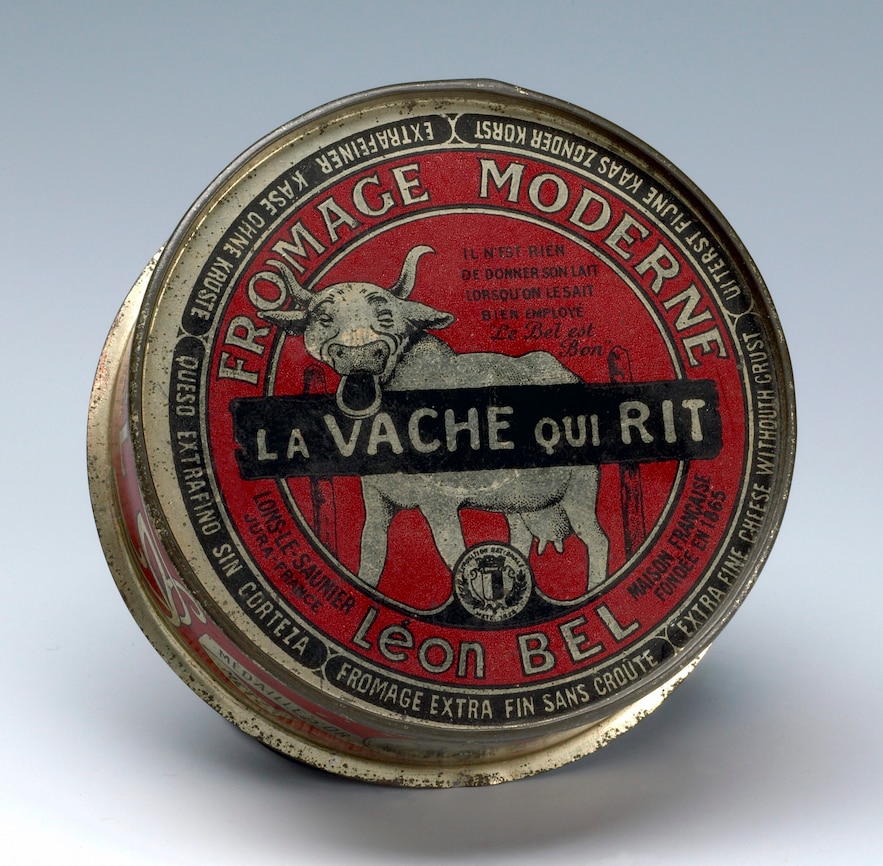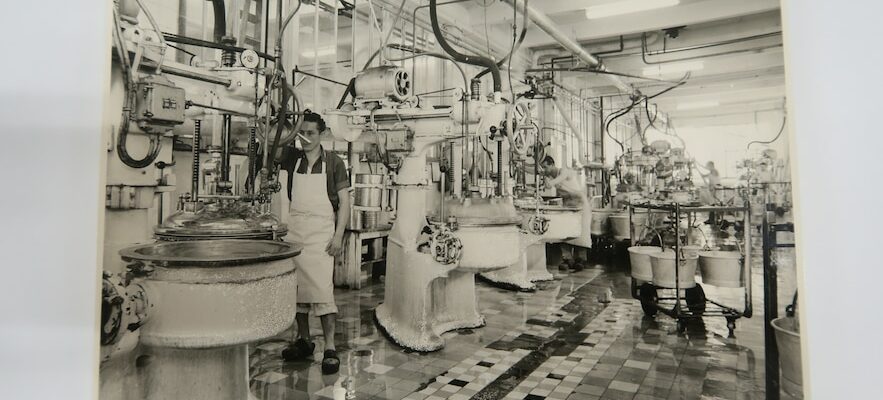Headquarters, factories, stores, these places constitute the starting points of some of the greatest French industrial and commercial sagas. In this summer seriesL’Express opens the doors to emblematic sites, scattered across France.
EPISODE 1 – Renault: the true story of Building X, where it all began
EPISODE 2 – Carrefour: the little-known story of France’s first hypermarket
EPISODE 3 – From the beginnings of electricity to the nuclear bomb: the great history of the CEA
At first glance, the town seems indolent, languidly nestled between the green hills of the Jura foothills. At the beginning of the last century, holidaymakers came to Lons-le-Saunier to treat their rheumatism in the salty, magnesium-rich waters of the Lédonia thermal baths. After a bit of shopping in the opulent boutiques on Rue des Arcades, the last evidence of the town’s medieval past, they would enjoy themselves in the evening under the gilded ceilings of the small Italian-style theatre. Hugo, Feydeau or Labiche. Today, spa visitors are becoming rarer. They have been replaced by tourists in shorts and trainers who have come here to celebrate a world-famous star: a small slice of melted cheese meticulously wrapped in an aluminium triangle set with a red thread and then carefully stored in a round cardboard box. In Lons-le-Saunier, the Laughing Cow even has its own museum. 50,000 visitors strolled through it last year – making it the most visited tourist site in the department. Fans, collectors and families – lots of them – the kids leaving the place with crimson cheeks, proudly sporting a cap or a T-shirt with the emblem of the hilarious quadruped. Loyal consumer. Eternal conquest.
The Laughing Cow is probably the best-selling French product in the world. 120 portions consumed every second in nearly 120 countries. North America, Maghreb, Middle East, Africa, South Asia, Japan… Each country has its own price, depending on the purchasing power of the population. Much more than a slice of cheese. A model, copied a thousand times but never surpassed. And too bad if purists of soft or blue cheeses wrinkle their noses at the mention of this silver triangle. For hundreds of millions of consumers around the world, the Laughing Cow is a tricolor symbol. In Japan, the product, synonymous with French luxury, has been adopted by great chefs who use it in their recipes. In Africa or the Maghreb, the Laughing Cow, sold by the portion in roadside stalls, is the staple food of workers’ lunches, spread on a slice of flatbread.
Two main reasons for this global success. It is one of the least expensive proteins. Above all, it can be consumed in all latitudes because it does not have to undergo the imperatives of the cold chain. After pulling the little red thread, a consumer from the south of the Atlas will have the same taste experience as a Lapp, whatever the temperature: a fine and melting paste, slightly sticky to the finger and with a discreet cheese flavor. “The recipe nevertheless adapts to the tastes of the country and evolves according to the nutritional needs of the population”, reveals to L’Express Cécile Béliot, the general manager of the Bel group, owner of the brand. If in France, the plain version is popular, in the Maghreb, it is more olive flavored. Cumin or paprika in Eastern Europe. In the United States, we love it dressed with garlic and fine herbs, so “Frenchy”… 26 different flavors in total in the world. Where consumers, especially children, suffer from malnutrition, the portion is enriched with iron or magnesium. In France, it is slightly reduced in fat and in the United States, the triangles are larger. But everywhere the image is the same: a smiling red cow, white muzzle and small rounded horns, rings in the ears.
La Vache qui rit is the result of the marriage between a town, Lons-le-Saunier, and a family, the Bels, who will give their name to the Bel Group (3.6 billion euros in turnover in 2023). Not far from the train station, almost in the heart of the town, the historic factory is there, unchanging, a maze of buildings, staircases and gleaming pipes. A large sign, “Here we are recruiting”, welcomes the visitor. The factory employs a little over 370 people and the company is the largest private employer in the entire department. In Lons-le-Saunier, we have lived, grown and died with Bel for over a century. “La Vache qui rit is the marriage of two areas of expertise, that of processed cheese from neighbouring Switzerland and micromechanics specific to the Jura”, explains Yann Wederich, the factory director. No silver triangle without these famous machines designed by Bel engineers, perfected over the decades. Jewels of technology, now fully robotized, with breathtaking productivity. Nearly 20,000 tons of processed cheese leave the Lons-le-Saunier factory each year, mainly Laughing Cow cheese but also its derivatives, Apéricubes or Pik & Croq’ children’s snacks, small cheese trays in which breadsticks are dipped. Two thirds are exported.
Kneading room at the Bel factory in Lons-le-Saunier.
© / Beautiful
The story behind the drawing
It all began a few kilometres from Lons, in Orgelet, a small village where, in 1865, Léon Bel set up as a Gruyère cheese refiner in the cellars of a former convent. At the dawn of the new century, he bequeathed his business to his two sons, Léon and Henri, who decided to settle in town. A strategic location, not far from the train station to facilitate the marketing of the product and close to the salt marshes – salt, an essential element in the manufacture of cheese. Quickly, the youngest of the family took charge of the business but the First World War turned everything upside down. Léon was mobilized, in the Train, in charge of supplying the soldiers. His unit, the RVF70, took care of the supply of fresh meat. There he met Benjamin Rabier, a designer versed in anthropomorphism and who illustrated La Fontaine’s fables. The artist, who is not lacking in humour, drew on the wagons transporting the meat the image of a smiling ox, below which he wrote the “Wachkyrie”, in reference to the Valkyries “so dear to the Germans”. Upon demobilisation, Léon returned to Lons-le-Saunier. The company was failing, the cellars were full of large wheels that had aged badly. But he had an idea: to take inspiration from the Graf family, Swiss who had just settled in the town and were melting their cheese. A technique that allowed for better conservation and, above all, easier transport of the goods.
Léon Bel had a good head for business: he registered his trademark on April 16, 1921. The first portions packaged in round cardboard boxes appeared in 1924. But he needed an image. That’s when he remembered Rabier’s smiling ox. He contacted his regimental comrade again. He feminized the animal, colored it red – the first color that babies distinguish – and positioned the head to the right of the image – the right symbolizes the future. It was Anne-Marie Bel, Léon’s wife, who had the idea for the earrings, the rings in which the round cardboard box was reproduced endlessly. An impeccable mise en abyme. He then bought the rights to the image from Rabier for 1,000 francs.

First box of Laughing Cow.
© / Beautiful
Marketing had not yet been born, but Léon Bel was an ace. Aware of the need to popularize the brand, he was one of the first industrialists to create an “advertising office” that employed about fifteen people. He spent almost as much on “advertising” as he did on making his cheeses. Posters, enamel plaques, albums in which children stuck pictures, blotters and notebook covers, fleets of vehicles, invoice pads for grocers. In 1931, La Vache qui rit invaded the airwaves with a song performed by a certain Constantin le Rieur… Even Joséphine Baker got hold of the brand.
In this France of the Roaring Twenties, the Bels conquered Europe, first England, then Belgium and Northern Europe. The colonies, Indochina, Madagascar were all captive markets for the triangular portion. In 1926, the historic workshops moved to be even closer to the station: the factory then produced 20,000 boxes of Laughing Cow cheese per day. The Bels diversified, inventing Apéricubes, Babybel, Boursin, Kiri… In 1946, Léon Bel passed the torch to his son-in-law, Robert Fievet, who would remain at the head of the company until 1996! The family still owns most of the company’s capital. A sprawling group, the third largest cheesemaker in the world behind Lactalis and the American Kraft Food. In Lons, in the historic Léon Bel factory, the future is already being written. A small production line of vegan Laughing Cow has been running for eight months. An investment of 2.2 million euros. It took almost two years to perfect the recipe and rediscover the taste of the original portion. The ingredients? The secret is jealously guarded. Almond paste and corn starch. As for the rest, we won’t know more. These vegan portions are already marketed in England and the United States, where the market is more mature. On the box, the red cow, it keeps smiling.
.
